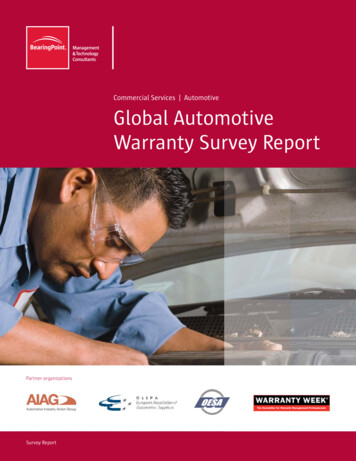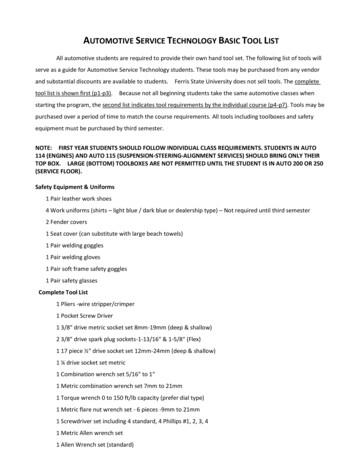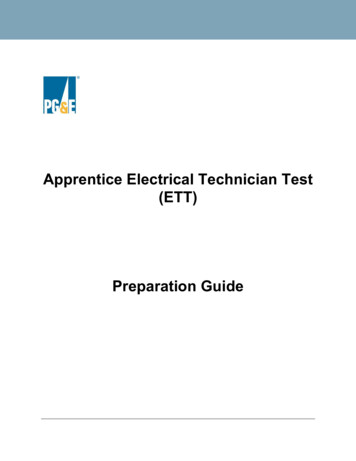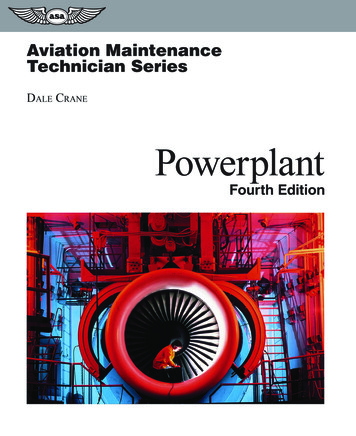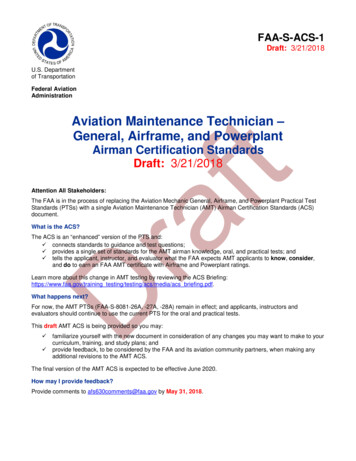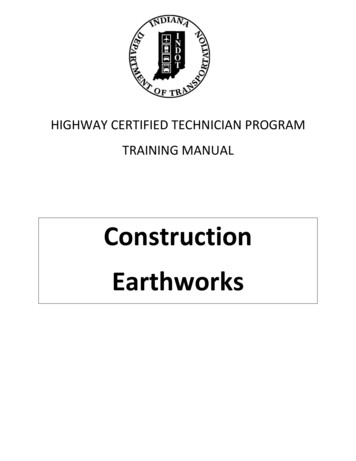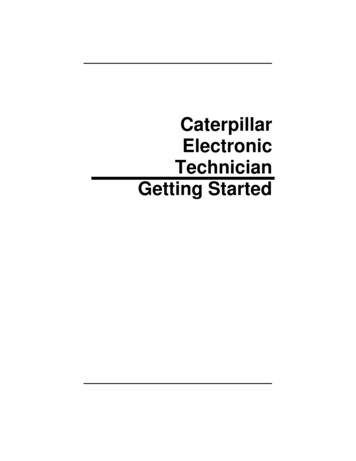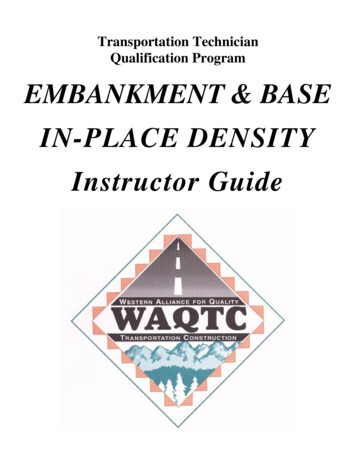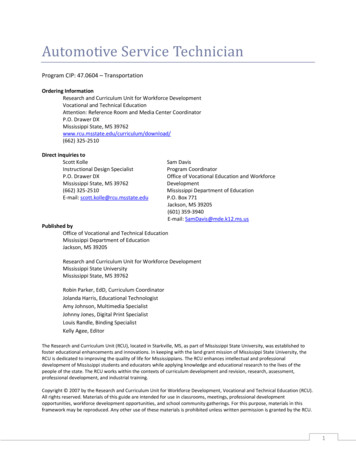
Transcription
Automotive Service TechnicianProgram CIP: 47.0604 – TransportationOrdering InformationResearch and Curriculum Unit for Workforce DevelopmentVocational and Technical EducationAttention: Reference Room and Media Center CoordinatorP.O. Drawer DXMississippi State, MS 39762www.rcu.msstate.edu/curriculum/download/(662) 325-2510Direct inquiries toScott KolleInstructional Design SpecialistP.O. Drawer DXMississippi State, MS 39762(662) 325-2510E-mail: scott.kolle@rcu.msstate.eduSam DavisProgram CoordinatorOffice of Vocational Education and WorkforceDevelopmentMississippi Department of EducationP.O. Box 771Jackson, MS 39205(601) 359-3940E-mail: SamDavis@mde.k12.ms.usPublished byOffice of Vocational and Technical EducationMississippi Department of EducationJackson, MS 39205Research and Curriculum Unit for Workforce DevelopmentMississippi State UniversityMississippi State, MS 39762Robin Parker, EdD, Curriculum CoordinatorJolanda Harris, Educational TechnologistAmy Johnson, Multimedia SpecialistJohnny Jones, Digital Print SpecialistLouis Randle, Binding SpecialistKelly Agee, EditorThe Research and Curriculum Unit (RCU), located in Starkville, MS, as part of Mississippi State University, was established tofoster educational enhancements and innovations. In keeping with the land grant mission of Mississippi State University, theRCU is dedicated to improving the quality of life for Mississippians. The RCU enhances intellectual and professionaldevelopment of Mississippi students and educators while applying knowledge and educational research to the lives of thepeople of the state. The RCU works within the contexts of curriculum development and revision, research, assessment,professional development, and industrial training.Copyright 2007 by the Research and Curriculum Unit for Workforce Development, Vocational and Technical Education (RCU).All rights reserved. Materials of this guide are intended for use in classrooms, meetings, professional developmentopportunities, workforce development opportunities, and school community gatherings. For this purpose, materials in thisframework may be reproduced. Any other use of these materials is prohibited unless written permission is granted by the RCU.1
2
Table of ContentsAcknowledgements. 5Preface . 9Automotive Service Executive Summary . 11Research Synopsis . 17Blueprint . 19Unit 1: Fundamentals I, Brakes, and Introduction to Electrical/Electronic Systems . 22Unit 2: Basic Electrical/Electronic Systems . 65Unit 3: Advanced Electrical/Electronic Systems . 81Unit 4: Engine Performance I . 96Unit 5: Engine Performance II . 123Unit 6: Suspension/Steering Systems and Alternative Fuels . 138Student Competency Profile for Automotive Service Technology . 158Recommended Tools and Equipment . 161Appendix A: 21st Century Skills Standards . 166Appendix B: Academic Standards . 167Appendix C: ACT College Readiness Standards . 173Appendix D: 2005 Automotive Service Program Standards . 186Appendix E: National Educational Technology Standards for Students . 1883
4
AcknowledgmentsThe Automotive Service Technology Curriculum Framework and Supporting Materials was adopted bythe Mississippi Board of Education on May 16, 2008. The following persons were serving on the stateboard at the time:Dr. Hank M. Bounds, Executive SecretaryMr. Claude Hartley, ChairMr. William Harold Jones, Vice ChairMr. Howell “Hal” N. GageDr. O. Wayne GannMs. Rebecca HarrisMr. Charles McClellandMs. Sondra Parker CaillavetMs. Rosetta RichardsDr. David SistrunkMike Mulvihill, as Interim Associate Superintendent of Education for the Office of Vocational Educationand Workforce Development at the Mississippi Department of Education, assembled an oversightcommittee to provide input throughout the development of the Automotive Service TechnologyCurriculum Framework and Supporting Materials. Members of this task force were as follows:Dr. Kay Berry, Simpson County School DistrictDr. Sam Bounds, Mississippi Association of School SuperintendentsMs. Beverly Brahan, Mississippi Association of EducatorsMr. David Campbell, Mississippi Association of Middle Level EducatorsMs. Tommye Dale Favre, Mississippi Department of Employment SecurityMs. Mary Hardy, Mississippi PTADr. Anna Hurt, Mississippi Association of School AdministratorsMr. Jay Moon, Mississippi Manufacturers AssociationDr. Dean Norman, Center for Advanced Vehicular Systems ExtensionMr. Michael Ray, Western Line School DistrictMr. George Schloegal, Hancock BankMs. Charlene Sproles, Mississippi School Counselor AssociationMr. Mike Thomas, North American Coal CorporationMr. Pete Walley, Institutions of Higher LearningMr. Clarence Ward, Boys and Girls Clubs of the Gulf CoastDr. Debra West, State Board for Community and Junior Colleges5
A special thanks is extended to the members of the Automotive Service Technology CurriculumFramework and Supporting Materials Professional Advisory Team. Members of this team include thefollowing:Dean Batton, Simpson County Vocational CenterAnnie Covington, Coffeeville Public SchoolsLinda Davis, Millsaps Vocational CenterDave Ellison, Hinds Community CollegeJimmy Flynt, Empire TrucksScott Kolle, Research and Curriculum UnitRick McDonald, Mississippi Gulf Coast Community CollegeTed Mangum, Jones County Vocational CenterMichael Myrick, Canton Career CenterTommy Nance, Fowler BuickRay Orr, Itawamba Community CollegeDanny Owen, Tupelo Public SchoolsBen Pratt, Northeast Mississippi Community CollegeRick Saucier, Hancock County Vo-Tech CenterChad Smith, Smith Brothers Collision RepairDale Smith, Thomson MachineryCravin Turnage, Holly Springs Public SchoolsEarl White, Mississippi Department of EducationAlso, a special thanks is extended to the teachers who contributed teaching and assessment materialsthat are included in the framework and supporting materials. Members who contributed are as follows:Dr. Paul Cuicchi, Starkville School District, Starkville, MSJohn McGee, Starkville School District, Starkville, MSDanny Owen, Tippah County School District, Ripley, MSNick Wages, Jackson County School District, Vancleave, MSJames Burrus, Panola County School District, Batesville, MSPrentiss Fults, Hinds County School District, Raymond, MSKevin Hancock, Madison County School District, Madison, MSDale Henry, East Mississippi Community College, Mayhew, MSAntoine Kimble, Oxford High School, Oxford, MSAppreciation is also expressed to the following staff members at the Mississippi Department ofEducation who provided guidance and insight throughout the development process:Sam Davis, Program Coordinator and Division Director, Office of Vocational Education andWorkforce Development, Mississippi Department of Education, Jackson, MSBill McGrew, Division Director of Instructional Programs and Student Organizations, Office ofVocational Education and Workforce Development, Mississippi Department of EducationChris Wall, Bureau Director of Instructional Programs and Student Organizations, Office ofVocational Education and Workforce Development, Mississippi Department of Education6
Finally, standards in the Automotive Service Technology Curriculum Framework and SupportingMaterials are based on the following:Industry StandardsNational Automotive Technicians Education Foundation was founded in 1983 as anindependent, nonprofit organization with a single mission: To evaluate technician trainingprograms against standards developed by the automotive industry and recommend qualifyingprograms for certification (accreditation) by ASE, the National Institute for Automotive ServiceExcellence. For more information, visit http://www.natef.org/. Reprinted with permission.Academic StandardsMississippi Department of Education Subject Area Testing ProgramACT College Readiness StandardsThe College Readiness Standards are sets of statements intended to helpstudents understand what is expected of them in preparation for theACT. These standards are integrated into teaching and assessmentstrategies throughout the curriculum framework.21st Century Skills and Information and Communication Technologies LiteracyStandardsIn defining 21st century learning, the Partnership for 21st Century Skills has embraced fivecontent and skill areas that represent the essential knowledge for the 21st century: globalawareness; civic engagement; financial, economic, and business literacy; learning skills thatencompass problem-solving, critical-thinking, and self-directional skills; and Information andCommunication Technology (ICT) literacy. Reprinted with permission.National Educational Technology Standards for StudentsReprinted with permission from National Educational Technology Standards for Students:Connecting Curriculum and Technology, copyright 2007, ISTE (International Society forTechnology in Education), 1-800-336-5191 (U.S. and Canada) or 1-541-302-3777 (International),iste@iste.org, www.iste.org. All rights reserved. Permission does not constitute an endorsementby ISTE.7
8
PrefaceSecondary vocational–technical education programs in Mississippi are faced with many challengesresulting from sweeping educational reforms at the national and state levels. Schools and teachers areincreasingly being held accountable for providing true learning activities to every student in theclassroom. This accountability is measured through increased requirements for mastery and attainmentof competency as documented through both formative and summative assessments.The courses in this document reflect the statutory requirements as found in Section 37-3-49, MississippiCode of 1972, as amended (Section 37-3-46). In addition, this curriculum reflects guidelines imposed byfederal and state mandates (Laws, 1988, ch. 487, §14; Laws, 1991, ch. 423, §1; Laws, 1992, ch. 519, §4eff. from and after July 1, 1992; Carl D. Perkins Vocational Education Act IV, 2007; and No Child LeftBehind Act of 2001).9
10
Automotive Service Executive SummaryProgram DescriptionAutomotive Service is a pathway for students in the Transportation career cluster. The followingdescription is from the current Standard Course of Study for Career–Technical Education, MississippiDepartment of Education.Industry CertificationThe Automotive Service pathway includes classroom and hands-on experiences that prepare studentsfor employment or continuing education in the auto service industry. This program was written toincorporate the National Institute for Automotive Service Excellence (ASE) learning objectives/contentand hours. Any student who successfully completes this program will be eligible to apply to obtain theASE exams. ASE requires 2 years of employment before certificates are issued. Students receive 1 yearof credit for completion of the secondary program. Students who take certifications before the 2-yearrequirement is met will be granted certifications after they complete 1 year of automotive employment.This is a national certification program recognized throughout the automotive service industry. Eachdistrict should implement a maximum student number due to the size of each lab.AssessmentStudents will be assessed using the Automotive Service MS-CPAS2 test. The MS-CPAS2 blueprint canbe found at p. If there are questions regardingassessment of this program, please contact the Transportation Instructional Design Specialists at theResearch and Curriculum Unit at 662.325.2510.Student PrerequisitesIn order for students to be able to experience success in the Automotive Service pathway, the followingstudent prerequisites are in place:1. C or Higher in English (the previous year)2. C or Higher in Math (last course taken, or the instructor can specify the math)3. Instructor Approvalor1. TABE Reading Score (eighth grade or higher)2. Instructor Approvalor1. Instructor ApprovalProposed Applied Academic CreditApplied Mathematics content from the curriculum was aligned to the 2007 Mississippi MathematicsFramework Revised Academic Benchmarks. It is proposed that upon the completion of this program,students will earn 1/2 Applied Mathematics credit that can be used for graduation requirements.11
Applied Physics content from the curriculum was aligned to the 2007 Mississippi Science FrameworkRevised Academic Benchmarks. It is proposed that upon the completion of this program (option 1 oroption 2), students will earn 1/2 Applied Physics credit that can be used for graduation requirements.The applied academic credit has not been approved by the Mississippi Commission on SchoolAccreditation or by the State Board of Education. If there are questions regarding applied academiccredit, please contact the Coordinator of Workforce Education at the Research and Curriculum Unit at662.325.2510.Licensure RequirementsA 966 educator license is required to teach the Automotive Service pathway courses. The requirementsfor the 966 licensure endorsement are listed below:1. Applicant must have earned a 2-year college degree (associate’s degree) or higher from anaccredited institution of higher education.2. Applicant must have 2 years of documented automotive service experience.3. Applicant must enroll immediately in the Vocational Instructor Preparation (VIP) or the RedesignEducation Program (REP).4. Applicant must complete the individualized professional development plan (PDP) requirementsof the VIP or REP prior to the expiration date of the 3-year vocational license.5. Applicant must hold ASE certificates in brakes, electrical/electronics, engine performance, andsteering and suspension.6. Applicant must successfully complete an approved computer literacy certification exam.7. Applicant must successfully complete a certification for an online learning workshop, module, orcourse that is approved by the Mississippi Department of Education.8. The applicant must successfully complete an Automotive Service certification workshop,module, or course that is approved by the Mississippi Department of Education.Professional LearningThe professional learning itinerary for the middle school or individual pathways can be found athttp://rcu.redesign.edu. If you have specific questions about the content of each training sessionprovided, you will need to contact the Research and Curriculum Unit at 662.325.2510 and ask forthe Professional Learning Specialist.Course OutlineThis pathway provides options for local school districts to implement based on student needs andscheduling demand. The first option groups units into one-credit courses for a total of four Carnegieunits. The second option groups units into two-credit courses. A description of each option is listed next.12
Option 1The Automotive Service pathway emphasizes industry-based content with time being allocated betweenlecture and lab activities. Safety is an integral part of every course and activity. The content is alignedwith National Institute for Automotive Service Excellence (ASE) standards to ensure that programs canbe recommended for certification by National Automotive Technicians Educational Foundation (NATEF).There are four courses in this option: Fundamentals I, Brakes, and Introduction to Electrical/ElectronicSystems; Advanced Electrical/Electronic Systems; Engine Performance I; and Engine Performance II andSuspension/Steering Systems and Alternative Fuels. Courses should be scheduled so the studentcompletes all courses in 2 years.Course Description: Automotive Service Fundamentals I, Brakes, and Introduction toElectrical/Electronic Systems course contains an introduction, safety, measurement, and tool/technicalreferences content. It also contains an introduction to brake systems: disc brakes, drum brakes, andantilock brakes. This course also contains an introduction to electrical/electronic systems informationand terminology. The Basic Electrical/Electronic Systems course contains electrical/electronic systemtheory, battery systems, starting systems, and charging systems.Course Description: Automotive Service Fundamentals II, The Advanced Electrical/Electronic Systemscourse contains information on lighting systems, concepts of gauges, warning devices, driverinformation systems, horn system, wiper/washer system, and accessories system diagnostic repair.Course Description: Automotive Service Fundamentals III, The Engine Performance I courses containinformation on safety, employability skills, basic automobile service, general engine components andtheory of operation, concepts of computerized engine control systems, and ignition systems.Course Description: Automotive Service Fundamentals IV, The Engine Performance II andSuspension/Steering Systems and Alternative Fuels courses contain information on fuel, air induction,and exhaust systems; concepts of emission control systems; concepts of engine service; generalsuspension/steering theory; steering system inspection, diagnosis, and repair; concepts of front, rear,and miscellaneous systems; and wheel/tire alignment concepts, alternative fuels general information forservice and maintenance.Automotive Service Fundamentals I (One Carnegie Unit) - Course Code: 997002Unit12TitleFundamentals I, Brakes, and Introduction to Electrical/Electronic SystemsBasic Electrical/Electronic SystemsHours8951130Note: The hours listed above are based on 140 hours of instruction for one Carnegie unit credit. ASEcertified programs are required to spend the following hours of instruction for the following units: Brakes and Electrical/Electronic Systems (135 hours) Basic Electrical/Electronic Systems (60 hours)13
Automotive Service Fundamentals II (One Carnegie Unit) - Course Code: 997003Unit3TitleAdvanced Electrical/Electronic SystemsHours140140Note: The hours listed above are based on 140 hours of instruction for one Carnegie unit credit. ASEcertified programs are required to spend the following hours of instruction for the following units: Advanced Electrical/Electronic Systems (140 hours)Automotive Service Fundamentals III (One Carnegie Unit) - Course Code: 997004Unit4TitleEngine Performance IHours140140Note: The hours listed above are based on 140 hours of instruction for one Carnegie unit credit. ASEcertified programs are required to spend the following hours of instruction for the following units: Engine Performance I (140 hours)Automotive Service Fundamentals IV (One Carnegie Unit) - Course Code: 997005Unit56TitleEngine Performance IISuspension/Steering Systems and Alternative FuelsHours4595140Note: The hours listed above are based on 140 hours of instruction for one Carnegie unit credit. ASEcertified programs are required to spend the following hours of instruction for the following units: Engine Performance II (80 hours) Steering and Suspension (95 hours) Safety will be reinforced and tested at the beginning of each course. Courses must be taken in order unless the instructor approves. Foundation knowledge in eachcourse must be mastered to move to the next unit. Students must complete automotive courses with a score of 80/C or higher in classwork toadvance to the next level. To effectively assess mastery respective to a course’s instructional hours, the pathway blueprintwill test units upon completion of their last hour of instruction.Option 2This Automotive Service pathway option also emphasizes industry-based content with time beingallocated between lecture and lab activities. The content is aligned with National Institute forAutomotive Service Excellence (ASE) standards to ensure that programs can be recommended forcertification by National Automotive Technicians Educational Foundation (NATEF). The content is14
divided into two courses. The content of the first course is Introduction, Safety, and Tools/TechnicalReferences, along with Basic Automotive Service, Brakes, Introduction to Electrical/Electronic Systems,and Basic Electrical/Electronic Systems. The second course content is Advanced Electrical/ElectronicSystems, Steering and Suspension, and Engine Performance content. Safety is an integral part of everycourse and activity. A student must complete both courses to be a completer and to receive the 1/2credit for physics and math.Course Description: Automotive Service Technology I (Course CIP Code: 997000)The Fundamentals, Brakes, and Introduction to Electrical/Electronic Systems course contains anintroduction, safety, measurement, and tool/technical references content. It also contains anintroduction to brake systems: disc brakes, drum brakes, and antilock brakes. This course also containsan introduction to electrical/electronic information and terminology. The Basic Electrical/ElectronicSystems course contains electrical/electronic system theory, battery systems, starting systems, andcharging systems. The Advanced Electrical/Electronic Systems course contains information on lightingsystems, concepts of gauges, warning devices, driver information systems, horn system, wiper/washersystem, and accessories system diagnostic repair.Course Description: Automotive Service Technology II (Course CIP Code: 997001)The Engine Performance I course contains information on safety, employability skills, basic automobileservice, general engine components and theory of operation, concepts of computerized engine controlsystems, and ignition systems. The Engine Performance II and Steering and Suspension course containsinformation on fuel, air induction, and exhaust systems; concepts of emission control system; conceptsof engine service; general suspension/steering theory; steering system inspection, diagnosis, and repair;concepts of front , rear, and miscellaneous systems; and wheel/tire alignment concepts; and alternativefuels general information for service and maintenance.Automotive Service I (Two Carnegie Units) - Course Code: 997000Unit123TitleFundamentals I, Brakes, and Introduction to Electrical/Electronic SystemsBasic Electrical/Electronic SystemsAdvanced Electrical/Electronic SystemsHours8951140280Note: The hours listed above are based on 140 hours of instruction for one Carnegie unit credit. ASEcertified programs are required to spend the following hours of instruction for the following units: Brakes and Introduction to Electrical/Electronic Systems (135 hours) Basic Electrical/Electronic Systems (60 hours) Advanced Electrical/Electronic Systems (140 hours)15
Automotive Service II (Two Carnegie Units) - Course Code: 997001Unit456TitleEngine Performance IEngine Performance IISteering/Suspension and Alternative FuelsHours1404595280Note: The hours listed above are based on 140 hours of instruction for one Carnegie unit credit. ASEcertified programs are required to spend the following hours of instruction for the following units: Engine Performance I (140 hours) Engine Performance II (80 hours) Steering and Suspension (95 hours) Scheduling and operating more than one course in the same classroom/laboratory with the sameteacher is not allowed. Students must complete the first year with a score of 80/C or higher in classwork to advance tothe next level. To effectively assess mastery respective to a course’s instructional hours, the pathway blueprintwill test units upon completion of their last hour of instruction.16
Research SynopsisData used to develop the Automotive Service Pathway were collected from a variety of sourcesincluding industry surveys and interviews; occupational employment projections; national standards;Mississippi Department of Education, institutions of higher learning, and community and junior collegerequirements; and state and national certification requirements. The pathway is designed to provide anoverview of the automotive service area to prepare students for careers in occupations predicted tohave a high number of available jobs in the next 10 years. These jobs are in the automotive servicesector. Industry input was collected from automotive service businesses in the state of Mississippi tocustomize the pathway to meet the needs of Mississippi’s employers. Employment projections wereobtained from the Mississippi Economic Review and Outlook, Mississippi Department of EmploymentSecurity, and the National Occupational Outlook Handbook. Students who successfully master thecurriculum should have the skills required to take the Automotive Service Excellence certification, whichis based on industry-validated performance indicators. Students should also be prepared to enterprograms for advanced education in the automotive fields. The pathway will articulate to automotiveservice programs offered in Mississippi’s community and junior colleges.Industry Job Data – Employment Projections 2004 to 2014 for MississippiNote: Compiled by Mississippi Department of Employment Security and Labor Market Information DepartmentOccupationCleaners of Vehicles andEquipmentAutomotive ServiceTechnicians andMechanicsTire Repairers andChangersAutomotive GlassInstallers2,4202,720Total ProjectedAvg. Annual JobOpenings3007,4208,6509802002004Employment2014 ProjectedEmploymentAverageHourlyAverageAnnual 8.55 17,790320 14.84 30,8701,07050 9.94 20,6702305 13.94 29,000Industry Comments and Quotes One of the main areas of concern for the industry representatives is many current techniciansare near retirement and there is a small number of young people interested in the automotivefield.Many of the employers agree that the ASE standards are important and need to be taughtthrough theory and hands-on application. Employers want employees to have the ASEcertifications but realize that the students still need time on the job to complete the “hoursworked in the field” requirement.Many employers compensate employees based on the number of certifications, and mostemployers encourage employees to obtain certification. Most employers have training programsavailable to allow employees to advance and obtain advanced certifications.Employers indicated that employees need to have customer service skills. They expectemployees to prioritize and organize tasks that will enable the vehicle to return to service assoon as possible.17
Basic computer skills are needed because many businesses use computers for record keepingand warranty claims.ArticulationHigh School ProgramS Automotive Service TechCommunity College ProgramPS Automotive TechCommunity College CourseATT 1213 - BrakesAcademic IntegrationAcademic skills mentioned included basic math, reading, and writing. Overall, the industryrepresentatives agreed that Brakes, Steering/Suspension, Electrical/Electronics, and Engine Performanceneed to be taught in the high schools. These are the basic building blocks for advanced training. Contentneeds to be taught as theory with hands-on application.Course ContentThe National Automotive Technicians Education Foundation (NATEF) was founded in 1983 as anindependent, non-profit organization with a single mission: To evaluate technician training programsusing standards that were developed by the automotive industry and recommend qualifying programsfor certification (accreditation) by ASE, the National Institute for Automotive Service Excellence. In 2004,the curriculum was strategically aligned to the standards to allow programs at a local level to becomecertified. The secondary programs were aligned with Brakes, Electrical/Electronic Systems,Suspension/Steering Systems and Alternative Fuels, and Engine Performance. Currently, there are fivecertified secondary programs in the state of Mississippi with more applying yearly. General brake systemdiagnosisHydraulic brakediagnosis and repairDrum brake diagnosisand repairDisc brake diagnosis andrepairPower assist unitdiagnosis and repairMiscellaneous diagnosisand repairAntilock brake andtraction control systems 18General electricalsystem diagnosisBattery diagnosis andserviceStarting systemdiagnosis and repairCharging systemdiagnosis and repairLighting systemsdiagnosis and repairGauges, warningdevices, and driverinformation systemsHorn and wiper/washerdiagnosis and repairAccessories diagnosisand repair General suspension andsteering systemsdiagnosisSteering systemsdiagnosis and repairSuspension systemsdiagnosis and repairWheel alignmentdiagnosis, adjustment,and repair General engine diagnosisComputerized enginecontrols diagnosis andrepairIgnition system diagnosisFuel, air in
Automotive Service is a pathway for students in the Transportation career cluster. The following description is from the current Standard Course of Study for Career–Technical Education, Mississippi Department of Education. Industry Certification The Automotive Service pathway includes

